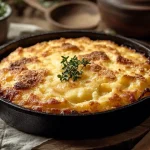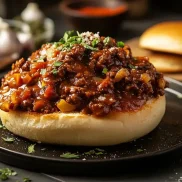What is the difference between cornbread and Southern cornbread? This question often sparks debate among food lovers, as these two versions of cornbread share similarities but also have distinct characteristics. Cornbread holds a cherished spot in the culinary traditions of the United States, celebrated for its versatility, simplicity, and rich history. But what makes cornbread so special, and how does it differ from its Southern counterpart?
Understanding these distinctions not only deepens our appreciation for this beloved dish but also provides insight into the diverse culinary landscape of America. In this article, we’ll explore the differences between cornbread and Southern cornbread, diving into their origins, variations, and key ingredients. By the end, you’ll have a clearer picture of what sets these two iconic styles apart. For a deeper dive into the classic Southern preparation, check out this detailed Southern cornbread recipe.
Table of Contents
Understanding Cornbread
Origins of Cornbread
Cornbread traces its roots back to the Native Americans, who cultivated corn as a staple crop long before European settlers arrived. They created simple, corn-based dishes, such as ash cakes and pone, using ground cornmeal and water. When settlers adopted these techniques, they adapted the recipes to include ingredients like milk, eggs, and leavening agents. This fusion marked the beginning of modern cornbread as we know it today.
Over the centuries, cornbread became a symbol of sustenance and practicality. It was a staple for pioneers, farmers, and families living in regions where wheat flour was scarce or expensive. The affordability and ease of preparation made cornbread a household favorite, ensuring its place in American kitchens for generations.
Variations of Cornbread Across Regions
Cornbread’s adaptability has led to numerous regional variations across the United States. In the Northern states, cornbread tends to be sweeter, often incorporating sugar or honey to cater to local palates. It’s typically lighter and cake-like in texture. Meanwhile, Western variations might include additions like green chilies or cheese, reflecting the culinary influences of Mexican and Southwestern cuisines.
In contrast, Southern cornbread embraces a savory profile, often omitting sugar entirely. It’s known for its rich, crumbly texture and golden crust, achieved by baking in a preheated cast-iron skillet. These distinctions underscore the regional tastes and cultural influences that shape cornbread recipes.
Classic Cornbread vs. Modern Interpretations
The debate over what defines “classic” cornbread is ongoing. Traditional recipes emphasize simplicity—cornmeal, water, salt, and fat (usually lard or bacon grease). Modern interpretations, however, experiment with diverse ingredients, including buttermilk, butter, sweeteners, and even alternative flours. While some purists argue that these additions stray too far from cornbread’s humble origins, others see them as a natural evolution, reflecting contemporary tastes and dietary preferences.
Key Ingredients in Traditional Cornbread
Traditional cornbread relies on a few essential ingredients that highlight its rustic charm. Cornmeal, the cornerstone of the dish, imparts a distinctive grainy texture and earthy flavor. Depending on the grind (fine, medium, or coarse), the texture of the final product can vary significantly. Water or buttermilk serves as the liquid base, ensuring a moist consistency.
Fat, such as bacon grease or butter, not only adds richness but also helps create a crisp crust when baked in a hot skillet. Finally, salt enhances the natural sweetness of the cornmeal, while leavening agents like baking soda or baking powder provide a subtle rise, giving the bread its characteristic lightness.
Whether it’s a sweet Northern-style cornbread or a savory Southern rendition, the ingredients and techniques used in traditional cornbread continue to reflect its enduring appeal and versatility.
Diving Into Southern Cornbread
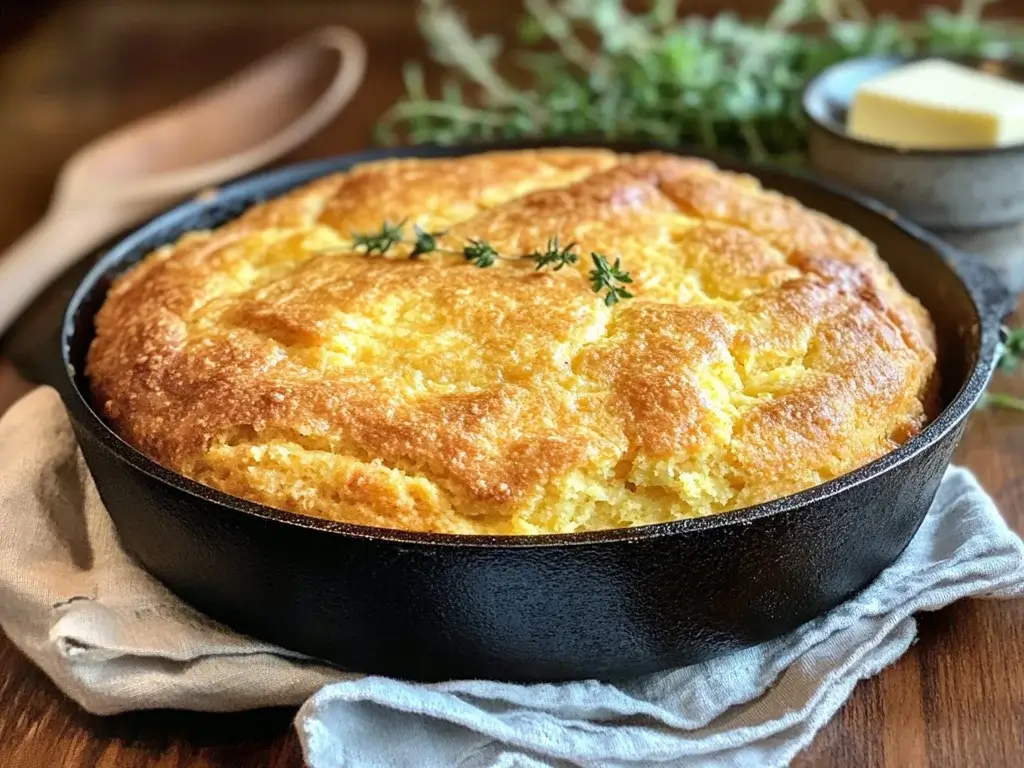
The Unique History of Southern Cornbread
Southern cornbread’s history is deeply rooted in the cultural and agricultural heritage of the American South. Unlike its sweeter Northern counterpart, Southern cornbread evolved as a savory staple, shaped by the region’s available ingredients and culinary traditions. Cornmeal became the cornerstone of Southern cooking because wheat flour was often too expensive or hard to come by. Enslaved African Americans and poor farming families relied on cornmeal to create nourishing and affordable meals, leading to the development of recipes that are still beloved today.
This cornbread was not just a practical choice but a cultural expression. It was served alongside hearty meals like collard greens and beans, becoming a symbol of sustenance and comfort in Southern households. Over time, Southern cornbread became a culinary icon, representing the resilience and ingenuity of the people who created it.
Cultural Significance in the Southern United States
In the South, cornbread is more than just a side dish—it’s a cherished tradition. Families pass down recipes through generations, each with their own special twist. It often accompanies Sunday dinners, holiday feasts, and community gatherings, bringing people together over its warm, crumbly goodness. The preparation itself is a ritual, with many home cooks insisting on using cast-iron skillets to achieve the perfect golden crust.
Cornbread also holds a special place in Southern literature and folklore, often symbolizing hospitality and comfort. It’s a dish that evokes nostalgia and pride, reminding people of simpler times and the enduring power of home-cooked meals.
How Southern Cornbread Differs in Texture and Taste
Southern cornbread stands out for its savory profile and unique texture. Unlike Northern cornbread, which is often sweet and cake-like, Southern cornbread is crumbly, dense, and packed with flavor. The lack of sugar is a defining characteristic, allowing the natural sweetness of the cornmeal to shine. The use of bacon grease or lard instead of butter adds a smoky richness that’s hard to replicate.
Another key difference lies in the cooking technique. Southern cornbread is traditionally baked in a preheated cast-iron skillet, creating a crispy, golden crust that contrasts beautifully with the tender interior. This method not only enhances the flavor but also adds to the dish’s rustic appeal.
The Role of Buttermilk and Cornmeal in Southern Recipes
Buttermilk and cornmeal are the stars of any authentic Southern cornbread recipe. Buttermilk’s tangy flavor complements the earthiness of the cornmeal, creating a balanced and flavorful bread. It also reacts with leavening agents like baking soda, ensuring a light and tender crumb despite the dense texture.
Cornmeal, whether white or yellow, defines the cornbread’s texture and taste. Southern recipes typically use stone-ground cornmeal, which retains more of the corn’s natural flavor and texture compared to the finely milled varieties found in other regions. This coarser grind gives Southern cornbread its signature grit and hearty mouthfeel, setting it apart from other variations.
Together, these ingredients create a dish that is unmistakably Southern, embodying the region’s rich culinary traditions and love for bold, comforting flavors.
Cooking Techniques and Methods
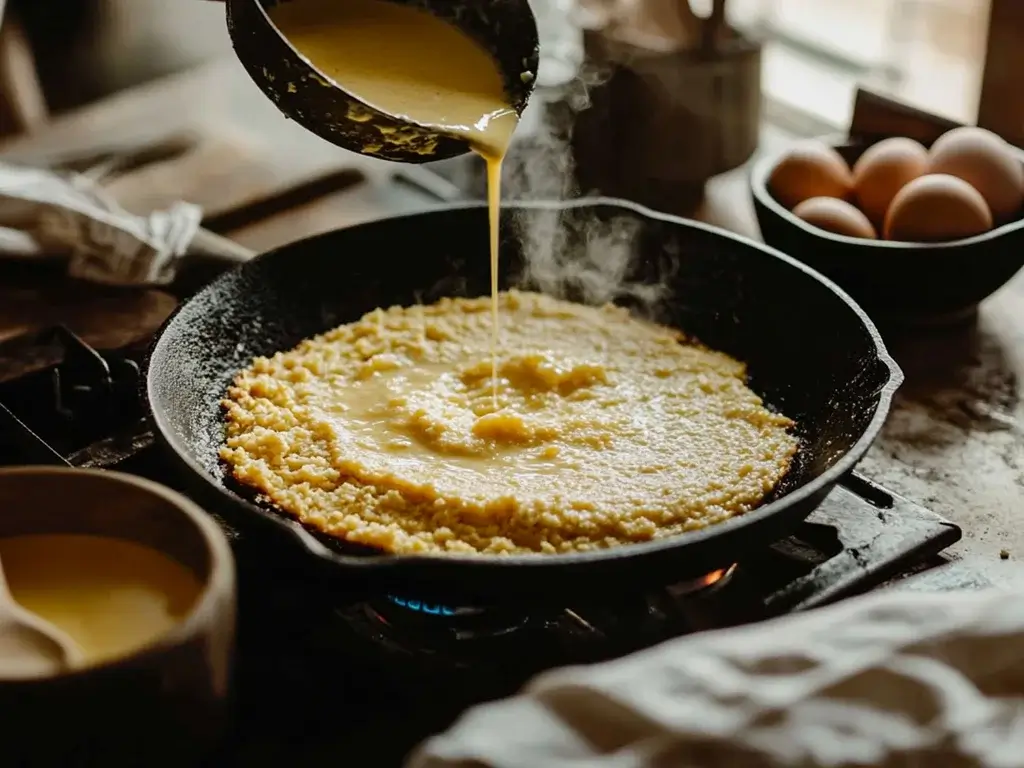
Baking Cornbread: Methods and Tools
Baking cornbread is an art that combines simplicity with precision. The tools and techniques used play a significant role in the final outcome, from the texture to the flavor. Traditionally, cornbread is baked in ovens, but modern variations also include stovetop and even outdoor Dutch oven methods. Regardless of the approach, the choice of tools, such as mixing bowls, whisks, and baking pans, affects the process.
For those aiming for a classic cornbread, using a preheated oven ensures even cooking and a well-developed crust. Metal or cast-iron pans are preferred for their ability to conduct heat efficiently. Glass or ceramic dishes can also be used, but they may not yield the signature crispiness associated with cornbread.
Careful attention is required during the mixing stage. Overmixing can lead to a dense texture, so it’s essential to combine ingredients gently until just incorporated. The batter should be poured into a hot, greased pan to kickstart the crust formation. Baking times typically range from 20 to 30 minutes, depending on the recipe and pan size.
The Role of Cast Iron in Southern Cornbread
Cast iron is synonymous with Southern cornbread, and for good reason. This kitchen staple provides unparalleled heat retention and even distribution, which are crucial for achieving the perfect cornbread. When a cast-iron skillet is preheated and greased, it forms a hot, nonstick surface that sears the batter upon contact. This initial sizzle creates a crust that is both crispy and flavorful.
The skillet’s versatility extends beyond its heat properties. It allows cornbread to transition seamlessly from stovetop to oven, offering consistent cooking throughout. Cast iron also imparts a subtle, smoky flavor, especially when seasoned properly over time. This flavor is a hallmark of Southern cornbread, elevating it above other variations.
Maintaining a cast-iron skillet requires some care, including proper seasoning and cleaning methods. However, the results are well worth the effort, as this timeless tool ensures every batch of cornbread is a culinary masterpiece.
Achieving the Signature Crust of Southern Cornbread
The signature crust of Southern cornbread is what sets it apart, and achieving it requires attention to detail. Preheating the skillet is the first and most critical step. A hot skillet ensures that the batter begins cooking immediately upon contact, forming a crust that is golden and crisp.
Greasing the skillet generously with bacon grease, lard, or vegetable oil adds another layer of flavor while preventing sticking. The batter should be poured into the skillet carefully to avoid disturbing the even layer of grease.
Temperature and timing also play a role. Baking at a high temperature—usually around 425°F—helps to create the desired texture. Once the cornbread is baked, letting it rest briefly allows the crust to firm up further, making it easier to slice and serve without crumbling.
Mastering these techniques ensures that every bite of Southern cornbread delivers the satisfying crunch and tender crumb that define this beloved dish.
What Is the Difference Between Cornbread and Southern Cornbread? Ingredient Comparison
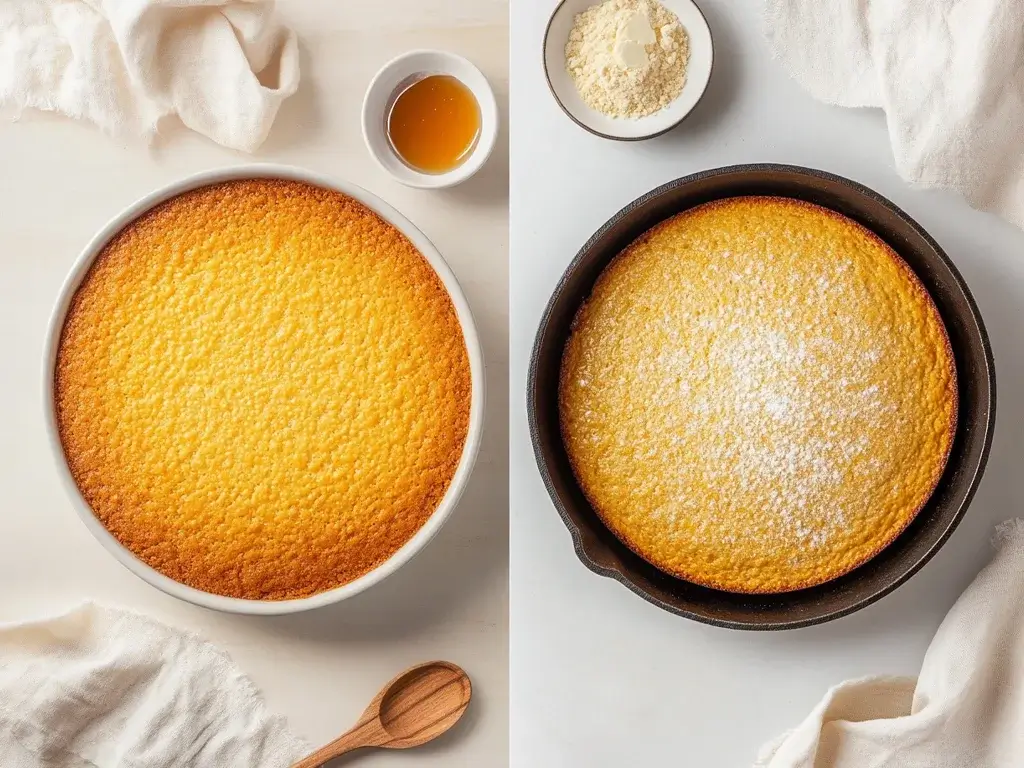
Sweet vs. Savory: A Debate of Flavors
One of the most notable differences between cornbread and Southern cornbread lies in their flavor profiles. Traditional cornbread from regions outside the South often leans towards sweetness, incorporating sugar, honey, or even molasses into the recipe. This sweeter version pairs well with chili or as a stand-alone snack, offering a dessert-like quality in some cases.
In contrast, Southern cornbread is staunchly savory. Sugar is rarely, if ever, added, allowing the natural flavors of the cornmeal to take center stage. The savory notes are often enhanced by using ingredients like buttermilk and bacon grease, which contribute richness and a slightly tangy undertone. This distinct lack of sweetness has sparked debates among food enthusiasts, with purists arguing that cornbread should never be sweet, while others appreciate the versatility of a sweeter rendition.
The Use of Sugar in Traditional Cornbread Recipes
The inclusion of sugar in traditional cornbread recipes is a relatively modern development. Historically, cornbread was a simple dish made with basic ingredients such as cornmeal, water, and salt. As sugar became more accessible and affordable, it started appearing in cornbread recipes, particularly in Northern regions where tastes skewed sweeter.
Southern recipes, however, remained true to their roots, avoiding sugar and focusing on savory elements. This divergence highlights regional culinary preferences and the influence of local ingredients. For instance, the availability of molasses in certain areas led to its occasional use as a sweetener in cornbread, adding a unique depth of flavor. Yet, in the South, the emphasis remained on creating a bread that could complement savory dishes like greens and beans, rather than serving as a sweet treat.
Differences in Fats: Butter vs. Bacon Grease
The choice of fat is another key distinction between cornbread and Southern cornbread. In traditional cornbread recipes, butter is the most commonly used fat. Its creamy texture and rich flavor make it an ideal choice for sweetened versions of cornbread, adding a luxurious quality to the crumb.
Southern cornbread, on the other hand, often relies on bacon grease or lard. These fats not only enhance the savory profile but also contribute to the characteristic crispy crust that defines Southern-style cornbread. The use of bacon grease infuses the bread with a subtle smokiness, creating a flavor that is deeply satisfying and uniquely Southern.
While butter lends itself to the softer, sweeter variations of cornbread, bacon grease and lard are essential for achieving the authentic taste and texture of Southern cornbread. This difference underscores the diverse culinary traditions that shape cornbread recipes across regions, offering something for every palate.
Regional Influences on Cornbread Recipes
Cornbread in the American South
The American South has long been synonymous with cornbread, where it is both a culinary staple and a cultural emblem. Southern cornbread reflects the region’s agricultural roots, utilizing local ingredients such as cornmeal and buttermilk to create a savory, rustic bread. It is traditionally baked in cast-iron skillets, which give it a distinctive golden crust. Southern cornbread’s versatility allows it to pair seamlessly with dishes like fried chicken, collard greens, and barbecue.
Appalachian vs. Lowcountry Cornbread
Even within the South, cornbread varies greatly depending on the region. Appalachian cornbread often leans toward simplicity, made with white cornmeal, water, and minimal additional ingredients. This version is dense, crumbly, and perfect for soaking up broths and stews. The rugged terrain and limited resources of the Appalachian region influenced its pared-down ingredients and straightforward preparation.
Lowcountry cornbread, by contrast, incorporates richer ingredients such as eggs, buttermilk, and sometimes sugar. This version reflects the coastal region’s diverse culinary influences, which include African and Caribbean flavors. Lowcountry cornbread tends to be lighter and more moist, making it ideal for standalone consumption or as a side to seafood dishes.
Northern Cornbread Characteristics
Northern cornbread diverges sharply from its Southern counterpart, often characterized by its sweetness and cake-like texture. Sugar, honey, or molasses are frequently added to the batter, giving it a dessert-like quality that appeals to Northern palates. Yellow cornmeal is the preferred choice, contributing to the bread’s vibrant color and softer texture.
Northern cornbread, unlike its crumbly and savory Southern counterpart, typically bakes in standard pans instead of cast iron, creating a uniform and delicate crumb. Cooks often serve this sweeter variation with butter or alongside chili and soups, showcasing its versatility as both a side dish and a snack.
How Climate and Corn Varieties Influence Recipes
Climate and corn varieties play a pivotal role in shaping cornbread recipes across regions. In the South, the warm climate is ideal for growing white corn, which has a milder flavor and finer texture compared to the yellow corn predominant in the North. White cornmeal forms the base of Southern cornbread, contributing to its earthy and savory profile.
In Northern states, yellow corn dominates due to the cooler climate and its suitability for growing in those conditions. Yellow cornmeal’s natural sweetness aligns with the region’s preference for sweeter breads, influencing both the flavor and texture of Northern cornbread.
These regional differences in climate and corn varieties not only determine the key ingredients but also highlight the adaptability of cornbread as a dish. By incorporating locally available resources, cornbread has evolved into a reflection of the communities and traditions that cherish it.
Frequently Asked Questions
Why do Southerners not put sugar in cornbread?
Southerners typically avoid adding sugar to cornbread because traditional Southern cornbread is meant to be savory rather than sweet. Historically, sugar was a luxury item in the South, so cornbread recipes relied on simple, accessible ingredients like cornmeal, buttermilk, and bacon grease. The lack of sugar allows the natural flavor of the cornmeal to shine, making it an ideal accompaniment to savory dishes like greens and beans. Learn more
Is it better to use buttermilk or milk in cornbread?
Buttermilk is often considered the better choice for cornbread due to its tangy flavor and ability to react with baking soda or baking powder, resulting in a lighter, fluffier texture. The acidity in buttermilk also enhances the flavor of the cornmeal, giving Southern cornbread its distinctive taste. While milk can be used as a substitute, it may lack the depth of flavor and slight tartness that buttermilk provides. Learn more
What ingredient keeps cornbread from crumbling?
The key to preventing cornbread from crumbling is adding enough fat and moisture to the batter. Ingredients like eggs, buttermilk, and oil or bacon grease help bind the mixture together, resulting in a tender and cohesive texture. Additionally, using the right ratio of cornmeal to flour can prevent dryness, as too much cornmeal can make the bread crumbly. Learn more
What is the best type of cornmeal for cornbread?
Cooks often choose stone-ground cornmeal as the best type for cornbread because it retains more of the corn’s natural flavor and texture. In the South, cooks commonly use white cornmeal for its mild flavor, while in the North, people prefer yellow cornmeal for its sweeter and more robust taste. The grind size (fine, medium, or coarse) significantly influences the texture of the final product.
Can cornbread be made gluten-free?
Yes, cornbread can easily be made gluten-free by using 100% cornmeal or a mix of cornmeal and gluten-free flour. Many recipes also substitute traditional wheat flour with almond flour, rice flour, or a gluten-free baking blend. Ensure that any additional ingredients, such as baking powder, are also certified gluten-free to avoid cross-contamination.
How should cornbread be stored to keep it fresh?
Cornbread should be stored in an airtight container at room temperature for up to two days. For longer storage, it can be refrigerated for up to a week or frozen for up to three months. To maintain its texture, reheat cornbread in the oven at a low temperature before serving.
Conclusion
Cornbread and Southern cornbread may share a common origin, but their differences are a testament to the diverse culinary traditions across regions. From the savory, crumbly texture of Southern cornbread to the sweeter, cake-like variations found in the North, each style has its unique charm and flavor profile.
Whether you prefer the classic simplicity of a skillet-baked Southern cornbread or the indulgent sweetness of its Northern counterpart, cornbread remains a beloved dish that brings people together. Its adaptability to different tastes, ingredients, and cooking methods ensures that it will continue to be a staple in American kitchens for generations to come.
So, why not experiment with both styles and discover your favorite way to enjoy this iconic bread? The beauty of cornbread lies in its versatility and its ability to tell a story of tradition, innovation, and community.

